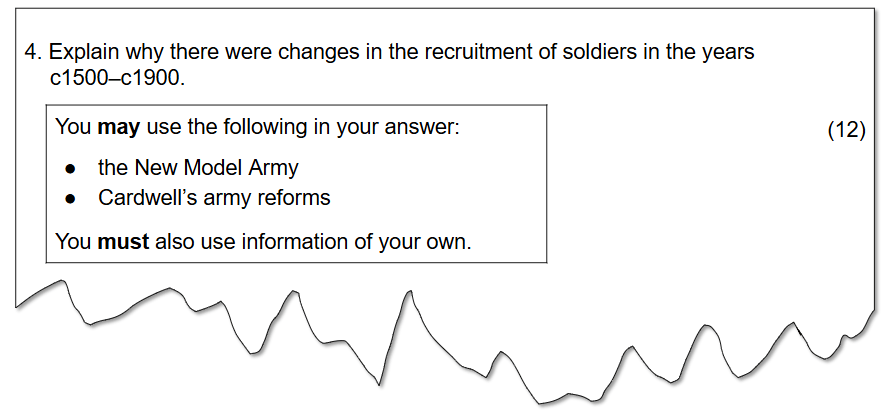The 12 Mark "Explain Why" Question (Edexcel GCSE History): Revision Note
Exam code: 1HI0
Summary of Question 4
Question 4 requires you to provide an analytical explanation of the event, development, theme or factor outlined in the question
This question will require you to use second-order concepts in your answer
Amount of marks | 12 |
|---|---|
The time that you should spend on the question | No more than 20 minutes 5 minutes of planning 10-15 minutes of writing |
An example of the type of question you may encounter can be seen below:

In previous years, this question has focused on the following topics in Warfare in British society:
Year of exam | Question topic |
|---|---|
2018 | Changes in the impact of war on civilians (opens in a new tab) |
2019 | Changes in the role of the mounted knight (opens in a new tab) |
2020 | Changes in the nature of warfare (opens in a new tab) |
2021 | How industrialisation led to changes in warfare (opens in a new tab) |
2022 | Changes in the recruitment and training of combatants (opens in a new tab) |
2023 | The feudal army decline in importance (opens in a new tab) |
2024 | Changes in people’s attitudes towards war |
What are second-order concepts?
Second-order concepts are thinking tools historians use to explain the past
The second-order concepts are:
Cause and consequence
Change and continuity
Similarities and differences
Historical significance
For the example question, the second-order concept is change and continuity
The example question asks you to explain why there were changes in the recruitment of soldiers
You can show change and continuity by considering:
The speed of change in weapons, attitudes to war or recruitment
What caused change or continuity in the nature or experiences of war
What caused improvements in the training of combatants or warfare tactics
How to answer an "Explain why" question
You are asked to explain a change, continuity or consequence in warfare
You will receive two stimulus points
These are areas of knowledge to discuss in your question
If you only discuss these two stimulus points, you cannot access Level 4 (9-12 marks)
You must discuss three areas of knowledge in your answer to access Level 4
You should always plan your answers before writing them. You should consider:
What three areas of knowledge you are going to use
For the example question, you could include patriotism, government acts (such as the Militia Acts) and the growth of the empire
How they demonstrate change, continuity or consequence across the time period outlined in the question
"Explain why" question structure
Your answer should include:
Specific and relevant own knowledge
The second-order concept in the question
A sustained explanation
A logical structure
Your answers could be written in PEEL paragraphs:
P — Make a point about the question
E — Use evidence that supports the point that you have made (K)
Use multiple pieces of evidence from the time period in the question
E — Explain the question (SOC)
Explain how the evidence caused a change, continuity or consequence in the development outlined in the question
L — Link your explanation to how significant this factor is for the change, continuity or consequence (SOC)
To achieve full marks, you need to repeat this structure three times
The question is out of 12 marks:
6 marks are for demonstrating a wide range of specific knowledge on the period and the topic (K)
6 marks are for the analysis of the key second-order concepts (SOC)
Worked example of an "Explain why" question
Worked Example
Explain why there were changes in the recruitment of soldiers in the years c1500–c1900.
(12)
You may use the following in your answer:
You must also use information of your own. |
Answer:
One reason recruitment changed in this period was the growing involvement of the state in warfare. In the early 1600s, recruitment was mostly the responsibility of local lords. However, this changed during the English Civil War with the creation of the New Model Army in 1645. It was a professional army, controlled by Parliament, and soldiers were paid regularly (K). This marked a significant change from earlier systems where soldiers were often unpaid or rewarded only by loot (SOC). Therefore, recruitment became more organised, and the government had more control over who joined and how they were trained. This shift made the army more effective and reliable during conflicts (SOC).
Another reason was the need for a larger, more professional army due to the demands of Britain's growing empire. The old system of voluntary enlistment and harsh discipline was no longer effective. This led to the Cardwell Reforms in the 1870s. These reforms banned the buying of commissions (which had allowed rich men to become officers) and improved conditions to attract better recruits (K). These changes made the army more appealing to ordinary working men and improved the quality of recruits. It marked a turning point where the British Army became a more modern, professional force (SOC).Therefore, recruitment focused on building a capable long-term military, rather than just filling numbers quickly during wartime.
A final reason was the changing attitudes in society. In the 1500s and 1600s, many people viewed soldiering as a low-status job, and armies often recruited from the poorest groups. Punishments were harsh, and desertion was common. However, by the 1800s, patriotism and national pride were stronger (K). The spread of newspapers, war reporting and propaganda encouraged patriotic feeling and helped to present the army positively. This change in public attitude made recruitment easier and increased the number of men willing to join voluntarily (SOC). Recruitment became about encouraging loyalty, pride and duty. This helped the government maintain a full-time, professional force by the end of the century.

Unlock more, it's free!
Did this page help you?